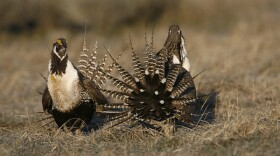The Greater Sage Grouse is a bird that incites fear in the hearts of western politicians, ranchers and oil companies. Not because it is fierce and numerous, but because it is the opposite -- a dwindling species, in danger of winking out, particularly as the lands it calls home are degraded or disrupted.
These diminishing sage grouse numbers mean it may soon be listed as endangered, a prospect that could halt money-making activities across Colorado and other states, from oil and gas drilling to ranching and recreation. Fearing this, Congress decided to get involved.
The Fish and Wildlife Service currently has a September 2015 deadline on deciding whether it plans to list the Greater Sage Grouse as threatened or endangered. But on Dec. 9, when Congress passed the spending bill that funds government through September 2015, legislators added a rider that effectively postpones that decision.
It does that in a fairly technical way, bypreventing the Service from spending any of its fundingto write a rule about whether or not the bird should be listed.
“It just basically the stops the funding from moving forward on what many consider a wrong-headed action by the department that would ultimately end up in litigation -- including litigation by the state of Colorado,” said Republican Rep. Cory Gardner, who supports the rider.
The rider would also prevent the Service from moving forward with developing plans related to a recent listing of a separate species -- the Gunnison Sage Grouse -- as “threatened” under the Endangered Species Act.
Conservationists concerned about the Greater Sage Grouse see the bill language as a setback, but are also focusing on the positive. The bill includes $15 million in funding for efforts to protect the landscapes where the bird lives. Overall, they say, conserving this land is what is most to the sage grouse's survival.
Colorado and other states across the west are currently working on these conservation plans, said Nada Culver, senior director for policy at the Wilderness Society. Culver said she hopes the deferral in a final decision does not slow down momentum on these efforts.
"What we are hoping is that we avoid this becoming an excuse for delay, and rather this is a time to keep working and get conservation in place so that we can avoid the need for a listing when the funding limitation ends."
Eric Holst, senior director of working lands at the Environmental Defense Fund, agreed.
"I hope there is no effect on what's really needed, which is on-the-ground conservation," Holst said. "I think there is a spirit of cooperation in Colorado right now among landowners, ranchers, conservationists and industry to try to bring populations of the bird back so that we can avoid listing."
Colorado will release its state plan on how to protect Greater Sage Grouse habitat in early 2015.
Grace Hood contributed reporting.







